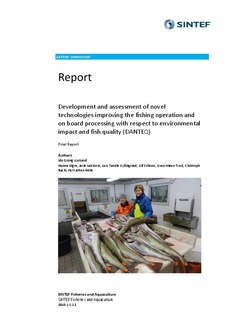| dc.contributor.author | Aursand, Ida Grong | |
| dc.contributor.author | Digre, Hanne | |
| dc.contributor.author | Ladstein, Jarle | |
| dc.contributor.author | Kyllingstad, Lars Tandle | |
| dc.contributor.author | Erikson, Ulf Gøran | |
| dc.contributor.author | Tveit, Guro Møen | |
| dc.contributor.author | Backi, Christoph Josef | |
| dc.contributor.author | Reite, Karl Johan | |
| dc.date.accessioned | 2017-06-26T18:46:55Z | |
| dc.date.available | 2017-06-26T18:46:55Z | |
| dc.date.created | 2016-12-12T11:22:34Z | |
| dc.date.issued | 2015 | |
| dc.identifier.isbn | 978-82-14-06014-0 | |
| dc.identifier.uri | http://hdl.handle.net/11250/2446961 | |
| dc.description.abstract | This is a final report of the project DANTEQ (2010-2015). Through this project new competence and new methods for optimal handling of whitefish onboard with respect to raw material quality and energy efficiency have been developed. The project was divided into four research areas; (1) catch handling, (2) chilling and freezing, (3) energy systems and (4) modelling. The main results are given below:
Short time live storage of fish befare killing: When towing times are short and catches are small a survival of 50-80 % was found for cod (density of fish in the storage tank varied from 120 to 550 kg/m3). The fishing depth has influence on survival rate. The stress level of the fish was lower straight after catch than after storage in live holding tanks onboard (not always significant differences). Less blood was found in fillets from live stored fish and fish processed straight after catch compared to commercial processed fish.
Electro stunning of fish: Voltage of 40 V DC is enough to achieve satisfactory immobilizing and easier handling of catch in connection with further processing (bleeding/gutting/heading) for cod, haddock and saithe. Three rows of electrodes on the stunner (current load for 4 - 6 seconds) is enough to achieve satisfactory immobilization. Electro stunning of saithe lead to broken backbone and bloodspots on 10 to 40 % of the fish.
Freezing of cod: Pre-rigor cod frozen in a magnetic field ((ell Alive System) achieved minimal differences in quality compared to traditional tunnel freezing and freezing in a cold room, in spite of different freezing rates. The mechanism for freezing of fish in magnetic field appeared to be similar to that of traditional freezing methods.
Chilling of cod and haddock: Fish stored in slurry had a different microstructure and different water distribution, measured by low field NMR, than those stored in flake ice. Differences in colour and QIMscore were found for haddock stored under the two conditions.
Logging of operational data: Software for acquisition and storage of operational data has been developed. Systems for acquisition and storage of operational data, as well as transfer of the data to an on-shore server, have been installed on-board two trawlers. Software for efficient analysis of operational data has been developed and used to generate operational profiles.
Model development: Methods and models for simulating catch handling processes have been developed, along with proof-of-concept software that demonstrates their practical use. Discrete event simulation seems to be a very suitable method for 5imulating and evaluating fish processing lines, though more work needs to be done with regards to model quality and validation. Acquiring high-quality data about catch handling processes for modelling purposes is difficult and labour-intensive. Future experiments should be designed to focus more on individual processes and less on the whole line, and should aim to keep better track of the "human factors" that add noise and affect the outcome. | nb_NO |
| dc.description.sponsorship | The Norwegian Research Council (NFR) | nb_NO |
| dc.language.iso | eng | nb_NO |
| dc.publisher | SINTEF Fiskeri og havbruk | nb_NO |
| dc.relation.ispartofseries | SINTEF Fiskeri og havbruk reports;A27309 | |
| dc.rights | Attribution-NonCommercial-NoDerivatives 4.0 Internasjonal | * |
| dc.rights.uri | http://creativecommons.org/licenses/by-nc-nd/4.0/deed.no | * |
| dc.title | Development and assessment of novel technologies improving the fishing operation and on board processing with respect to environmental impact and fish quality (DANTEQ) | nb_NO |
| dc.type | Research report | nb_NO |
| dc.description.version | publishedVersion | nb_NO |
| dc.rights.holder | SINTEF Ocean | nb_NO |
| dc.source.pagenumber | 66 | nb_NO |
| dc.identifier.cristin | 1411328 | |
| dc.relation.project | Norges forskningsråd: 199447 | nb_NO |
| cristin.unitcode | 7566,5,0,0 | |
| cristin.unitcode | 7566,2,0,0 | |
| cristin.unitname | Prosessteknologi | |
| cristin.unitname | Fiskeriteknologi | |
| cristin.ispublished | true | |
| cristin.fulltext | original | |

